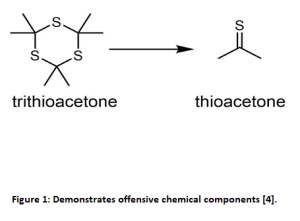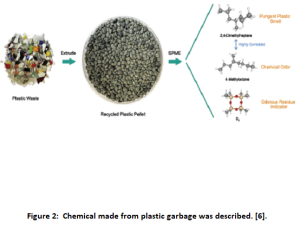Hamida Edan Salman and Inam Joudah Radhi
Department of Chemistry, College of Education for Pure Sciences, University of Karbala, Iraq.
Abstract:
Chemicals with offensive odors can arouse the sense of smell and be either natural or synthetic. Most people can tell the difference between appealing and offensive scents. This review aims to examine these substances’ significance and negative effects on the ecosystem.
Keywords: natural chemical, Smelling chemicals, and Odors.
Introduction:
The smelly smell that permeates the industrial and nearby waste processing sites is a constant worry for preserving the environment and, particularly, the quality of life. Membrane-based approaches or processes are effective choices among the various alternatives for eliminating drug residues that cause an unpleasant odor in the air [1]. They are chemical substances, either natural or synthetic, that can arouse the sense of smell. Most people can distinguish between pleasing and offensive scents [2]. The quantity of volatile organic compounds (VOCs) released by wood-based panels and other items is a major influence when researching indoor air quality. Even at quantities below the detection limit, VOCs can still cause harm. Figure 1 shows that the smell that the bat emits is a combination of two thiols (compounds with SH groups) [3].
Although the management of plastic trash is moving toward recycling in many nations, figure 2 shows that the melting process used in facilities that utilize this technique for handling plastic waste may release toxicants and irritate the senses [5].
⦁ Compounds that have an unpleasant odor [7]:
⦁ Butanethiol: It is a liquid thiolate-organic sulfur compound with the chemical formula (C4H10S), and it is clear, odorless, and colorless. Due to the presence of this chemical, which is also present in bat secretions and adds odor to domestic gas, there is a stench.
⦁ Cyclo-Octadiene: A compound in organic chemistry that is a member of the unsaturated cyclic compound class. Its symbol is C8H12, and it consists of an octahedron with two double bonds. It is an odorless chemical used in organometallic chemistry with a strongly disagreeable smell.
⦁ Methane-thiol (known as methane thiol): is a colorless organic molecule with the chemical formula CH3SH that has a distinctive dry odor. It is a naturally occurring chemical present in human, animal, and plant tissues, including the brain and blood. Animal feces help remove it from the environment. It is combustible, causes terrible breath and the odor of stomach gas, is utilized in the plastics sector.
⦁ Ammonia (ammonia or ammonia), it is an odorless alkaline gas and has the chemical symbol NH3. Ammonia is lighter than air and has an overpowering smell. Ammonia does not burn in the air but does burn in the presence of oxygen with a feeble yellow flame. Ammonia, which may be produced by distilling coal or other nitrogenous materials, is very soluble in water.
1.2 Elimination of unpleasant odors
1- Get rid of the source of the smell with a deodorizer: Using an enzymatic cleaner designed for this kind of stain, you must first remove the smell’s source from the surface where it is hidden.
2- Reduce bad odors: When dealing with stinky automobiles, this approach is less difficult to implement than stain removal and is also risk-free. Certain substances can easily pick up offensive scents if aromatic chemicals readily bond to other molecules. as in utilizing (sodium bicarbonate).
3- Close and isolate it: After cleaning, if the stench persists, evaporate the vinegar and add sufficient carbon. The material or ingredient that causes this stench must be permanently eliminated after these processes. By either employing a gas stopper or removing such objects [8].
1.3 Diseases caused by unpleasant odors:
Unpleasant smells, while not always being the direct cause of negative health impacts, have historically been seen as indications or warning signals of possible hazards to human health. But citizen complaints to public health organizations reveal that scents may not only act as a warning of possible threats but that odor perceptions themselves may induce health issues. Large animal production facilities and wastewater treatment facilities, for instance, can cause unpleasant odors that cause complaints of eye, nose, and throat irritation, headache, diarrhea, hoarseness, sore throat, cough, chest tightness, nasal congestion, palpitations, shortness of breath, stress, sleepiness, and mood changes. [9].
1.3.1 Metabolic disorders:
Metabolic imbalance is another medical problem that results in bad odor emanating from your body. Genetic changes that result in body odor are to blame for this [10]. Your body, breath, and urine all emit exceedingly offensive scents as a result of these many chemical components. Since a result, if you notice a bad smell coming from your breath, body, or urine, you should get a metabolic condition checked for and treated as this will instantly lessen body odor [11].
1.3.2 diabetes:
Body odor is one of the numerous health problems that diabetics encounter, and the source of this is elevated blood glucose levels, which can impair several bodily processes and result in unpleasant body odor [12]. However, if a person with diabetes has diabetic ketoacidosis, their body can release a fruity smell, which is the exact opposite of what you might feel otherwise. As a result, you should tell your doctor about this and get treatment because diabetic ketoacidosis is a complication of life-threatening health [13].
References:
⦁ Nechifor, A. C., Cotorcea, S., Bungău, C., Albu, P. C., Pașcu, D., Oprea, O., … & Nechifor, G. (2021). Removing of the sulfur compounds by impregnated polypropylene fibers with silver nanoparticles-cellulose derivatives for air odor correction. Membranes, 11(4), 256.
⦁ Engen, T. (1991). Odor sensation and memory. Greenwood Publishing Group.
⦁ Liu, Y., Zhu, X., Qin, X., Wang, W., Hu, Y., & Yuan, D. (2020). Identification and characterization of odorous volatile organic compounds emitted from wood-based panels. Environmental Monitoring and Assessment, 192(6), 1-10.
⦁ Le Cocq, C., & Lallemand, J. Y. (1981). Precise carbon-13 NMR multiplicity determination. Journal of the Chemical Society, Chemical Communications, (4), 150-152.
⦁ Tsai, C. J., Chen, M. L., Chang, K. F., Chang, F. K., & Mao, I. F. (2009). The pollution characteristics of odor, volatile organochlorinated compounds and polycyclic aromatic hydrocarbons emitted from plastic waste recycling plants. Chemosphere, 74(8), 1104-1110.
⦁ Fuller, J., White, D., Yi, H., Colley, J., Vickery, Z., & Liu, S. (2020). Analysis of volatile compounds causing undesirable odors in a polypropylene-high-density polyethylene recycled plastic resin with solid-phase microextraction. Chemosphere, 260, 127589.
⦁ McQueen, R. H., & Vaezafshar, S. (2020). Odor in textiles: A review of evaluation methods, fabric characteristics, and odor control technologies. Textile research journal, 90(9-10), 1157-1173.
⦁ Furrer, J. (2021). Old and new experiments for obtaining quaternary-carbon-only NMR spectra. Applied spectroscopy reviews, 56(2), 128-142.
⦁ Schiffman, S. S., & Williams, C. M. (2005). Science of odor as a potential health issue. Journal of environmental quality, 34(1), 129-138.
⦁ Whittle, C. L., Fakharzadeh, S., Eades, J., & Preti, G. (2007). Human breath odors and their use in diagnosis. Annals of the New York Academy of Sciences, 1098(1), 252-266.
⦁ Furrer, J. (2012). A comprehensive discussion of hmbc pulse sequences, part 1: The classical HMBC. Concepts in Magnetic Resonance Part A, 40(3), 101-127.
⦁ Awuchi, C. G., Echeta, C. K., & Igwe, V. S. (2020). Diabetes and the nutrition and diets for its prevention and treatment: a systematic review and dietetic perspective. Health Sciences Research, 6(1), 5-19.
⦁ Elyashberg, M., & Argyropoulos, D. (2021). Computer assisted structure elucidation (CASE): current and future perspectives. Magnetic Resonance in Chemistry, 59(7), 669-690.































































